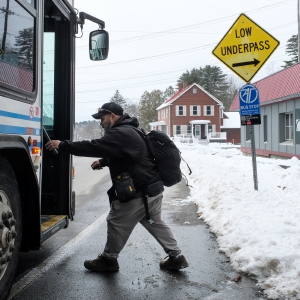A Look Back: Muddy roads of springs past
| Published: 04-03-2023 4:54 AM |
Upper Valley roads are wicked muddy this spring? Ha! Go back a few decades, or maybe a century or two — that’s when just about every road around here was a muddy slog, even in downtowns, for weeks on end. Little wonder folks then actually liked winter over spring because when things were frozen up hard they could get around.
From the region’s very first settlement in the 1760s muddy roads have posed challenges that have tested the mettle of man and beast, while today’s ruts and wallows would be but small nuisances to those who lived in these parts a couple of centuries ago. Long mud seasons became part of the DNA of the region from the get-go, slowing and often stopping commerce and social interaction.
Modern equipment and knowhow have made mud season manageable. The principal treatment for muddy roads became gravel early on, and it remains the basic material for building and maintaining roads today. For two centuries it was dump carts hauled by teams of horses and oxen, their cargos loaded by hand with shovels. In most towns it was farmers who supplied the labor and conveyances, usually as a means to work off their tax liability. The worst sections of mud usually got some gravel when things dried out.
Post-World War I came machinery to excavate gravel and dump trucks to haul the stuff, launching a half-century assault on muddy roads. With them came better management of drainage and in some instances the introduction of what at first were called “hard surface” treatments, initially concrete and subsequently asphalt. The 1930s brought “state roads” — town roads taken over by the state to link population centers — and paved roads soon became a greatly valued community attribute.
Those roads that stayed town resources would slowly be upgraded through the 1970s and some would be paved. But gravel remained the basic ingredient of road construction and the primary surface upon which vehicles traveled. Gravel would be excavated from pits opened hither and yon across the landscape and it came cheap — 10 cents a cubic yard was the going price in some towns as late as 1975 — and before state water quality laws came along much Upper Valley gravel was excavated of stream beds.
An argument can be made that around 1980 many towns figured enough gravel had been laid down that muddy roads had become but a minor concern, so they shifted focus more toward upgrading culverts and bridges and expanding the mileage of paved roads. Gravel had become far more expensive, the trucks to haul it ever more costly and, well, it seemed like mission accomplished.
But Mother Nature had and still has other ideas. Numerous studies done by state transportation agencies and university researchers say that about one inch of material is lost from a gravel road annually due to sheet erosion — the thundershowers and rainstorms that dump water at sufficient volume and intensity to carry off the particles of gravel to adjacent ditches and on into waterways. This continuing assault thins the gravel layer and eventually reaches down to the dirt, the stuff of mud, beneath.
And there are other forces, too, like heavy traffic creating dust, heavier trucks flexing the gravel layer and, especially this year, climate change which has brought a freeze-thaw cycle all winter that prevented a hard layer of frozen surface gravel from ever forming.
Article continues after...
Yesterday's Most Read Articles
 Upper Valley winter shelters kept dozens warm and dry
Upper Valley winter shelters kept dozens warm and dry
 Former principal of South Royalton School released from prison
Former principal of South Royalton School released from prison
 Owner of Friesian horse facility ordered to pay care costs for seized animals
Owner of Friesian horse facility ordered to pay care costs for seized animals
Upper Valley town selectmen and road agents today deal with the ongoing tension between keeping the gravel roads or converting them to asphalt pavement. Struggling along with the gravel surface a while longer is cheaper in the short run, but permanent pavement may be cheaper in the long haul. And there’s another issue layered on: some residents want to be done with muddy roads and dust and to get pavement down as soon as possible, while their neighbors want the “country road” to keep running past their house and say no thanks to pavement.
Steve Taylor lives and farms in Meriden and contributes occasionally to the Valley News.

 JAG Productions announces closure, citing ‘crisis facing the arts’
JAG Productions announces closure, citing ‘crisis facing the arts’ How a hurricane and a cardinal launched a UVM professor on a new career path
How a hurricane and a cardinal launched a UVM professor on a new career path Out & About: Vermont Center for Ecostudies continues Backyard Tick Project
Out & About: Vermont Center for Ecostudies continues Backyard Tick Project
